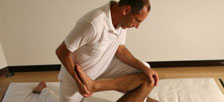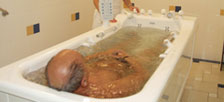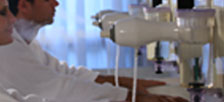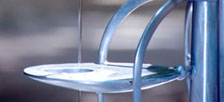Balneotherapy:
(Balneotherapy (Latin: balneum "bath") is the treatment of disease by bathing, usually practiced at spas, While it is considered distinct from hydrotherapy,[2] there are some overlaps in practice and in underlying principles. Balneotherapy may involve hot or cold water, massage through moving water, relaxation, or stimulation. Many mineral waters at spas are rich in particular minerals such as silica, sulfur, selenium, and radium. Medicinal clays are also widely used, which practice is known as 'fangotherapy').
Thermal water has constitutive and active properties which mean that balneotherapy, i.e. the total or partial immersion of the body in thermal water, is one of the main thermal therapies performed. Thanks to its special structure, during balneotherapy thermal water acts in a curative manner through certain stimuli – heat action, mechanical stress, physical-chemical and chemical action. As far as the heat component is concerned, it should be said that since water has the highest specific heat, a low conductivity coefficient and the possibility of being used in large quantities, it has a high heat retention capacity. Bodies with a high heat retention capacity are very useful in therapeutic practice since they can transmit heat in its best form – gradually without any sharp changes thus avoiding sudden and immediate heat charges in the tissues they come into contact with.
From a practical point of view, there are 3 types of baths - low mineralization or hypotonic, medium mineralization and high mineralization or hypertonic. The division is made according to the temperature and saline concentration of the mineral water used. In particular, three specific actions depend on the level of salt in the water. The first concerns the increase in the caloric action in accordance with the direct relationship between the specific weight and the heat and heat retention capacity.
The second strengthens the hydro mechanical action while the third is performed on the skin mantle, especially by hypertonic baths, with nervous stimulation, alteration of osmotic currents, etc. which cause internal stress of the body.
Thermal therapy is an indispensable treatment for many types vascular problems especially venous related conditions. Thermal balneotherapy at temperatures of between 32 and 36° with alkaline carbonic and bicarbonate water (carbon-gaseous baths) and also sulphated and sulphurous water and water containing salt and salt and bromide is the main focus of this treatment. Both for the hydrostatic effect and above all for the distinctive physical and chemical action contained in the composition of the mineral water. The results obtained with this treatment are clearly different from the results obtained by taking a bath in normal tap water. Ozone therapy, underwater massage, vascular gymnastics and postural drainage are all included in balneotherapy together with hygienic-dietary therapies which find a complete use in the concept of integral flebopathy thermal therapy. Balneotherapy can be performed in both individual and collective baths and in thermal pools and also in special tubs where it is possible to perform physiotherapy and rehabilitation activities. In particular it must be noted that immersion in thermal water can be combined with hydro massage treatment which consists in directing jets of different intensities onto the body while immersed in thermal water in order to stimulate blood circulation. In many spas hydro massage is also combined with walking in order to further stimulate the cardio circulatory system.
Balneotherapy can also be performed in sand therapy resorts, i.e. in thermal resorts located near the sea where sand bath therapy is performed. In this case, obviously sea water is used and baths can be taken either in pools (with water heated to a maximum of 36°) or directly in the sea (cold baths). Generally motor exercises are performed while in the water, either independently or directly (e.g. swimming) or various forms of kinestherapy where the patient remains immobile.
Immersion in seawater also boasts the massage effect produced by the movement of the waves which is of great benefit in stimulating the body in general. 'Hay baths' represent a particular type of balneotherapy. This ancient tradition of the valleys of the Trentino and Alto Adige regions has its origins in the farmers' habit of resting from a hard day's work by 'sleeping in the hay cut for the cows. This grass, apart from giving a creamy milk and excellent butter, also relieved the exhaustion of a day's work in the fields and gave the farmers their strength back.
In some areas in Trentino (and neighbouring Alto Adige) this peasant custom been rationally exploited for an important specific therapeutical purposes. This has happened for example in the Viote valley on Mount Bondone, where the grass is grown in abundance and specifically cut for the hay baths.
The grass, which contains a very particular mix of aromatic plants and medicinal such as thyme, arnica, creeping cinquefoil, gentian and many others, is cut and gathered at dawn or late evening (in some cases it is gathered during the day, provided the hay is still damp with dew). It is then stored in large basins where it is left to ferment for a few day.
When this natural boiling process is complete, one can begin the bathing process. The patient is almost completely immerged: at the beginning of the course of treatment for 15 minutes gradually increasing to half an hour. The hay beds are 50-60 centimetres wide and reach a superficial temperature of 40 degrees, while a temperature of 70 degrees has been measured below the surface. The patient, wrapped in a sheet and immerged in the hay bath at constant heat, sweats excessively and continues sweating for a few hours after termination of the treatment.
Fangotherapy (Mudtherapy)
Thermal mud is a special mixture formed of a claylike solid component, a liquid component (thermal water of different composition) and an organic component that mainly forms during the maturation period. Before the thirties clay was considered an amorphous and colloidal substance, while modern mineralogical methods have made it possible to highlight its most important components: the claylike minerals. The discovery of said minerals surely made for a better understanding of the mud's 'maturation process' which lasts from 1 to 2 years. An enrichment of vegetable and animal micro-organic substances occurs during this process and at the same time the various fractions that make up the mud become more closely mixed. According to their special structure, thermal muds act in a curative manner through specific stimuli – heat action, mechanical stress and physical-chemical and chemical action.
As far as the heat component is concerned, there is no other substance quite l ike mud which has the physical and physical-chemical properties needed to generate so much heat and slowly release it on the section covered in mud without causing any inconvenience.
The mud used can be natural (i.e. mud as it is found in nature without any subsequent modification or addition of substances) or artificial where specific processes are used to decide the mud's chemical components and properties.
Mud packs using thermal mud created by combining the solid component (claylike) and liquid component obtained from the springs are particularly suitable for treating dermatological, arthro-rheumatic (osteoarthritis) and locomotion problems, gout and also gynaecological complaints using a particular method of applying mud directly to the pelvis area in the form of 'underwear'. The solid and liquid components of the mud used, their chemical composition and their organic and inorganic characteristics can vary considerably which leads to a great selection of muds.
In muds , the liquid component can also be seawater while the solid component consists of mainly mineral components which generally come from the floors of lakes or lagoons or from the accumulation of detritus on the riverbed.
In peat, (which also come mainly from lakes or marshes) there is also a significant organic component due to the slow transformation process of the vegetable organisms which produced the peat. Mildews (the use of which at the Vinadio and Valdieri thermal spas is well-known) result from a combination of water (mainly sulphurous) with a solid component with a base of algae or other organic marine components. A particular type of fangotherapy is performed at Recoaro which uses ochre mud. This is the natural deposit that forms in tanks with water containing iron and is of a distinctive colour. It is particularly suitable for treating degenerative and post-traumatic arthropathy and fractures.








